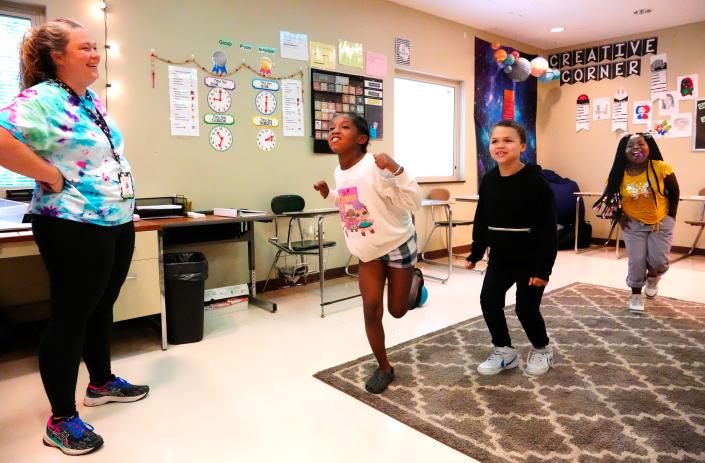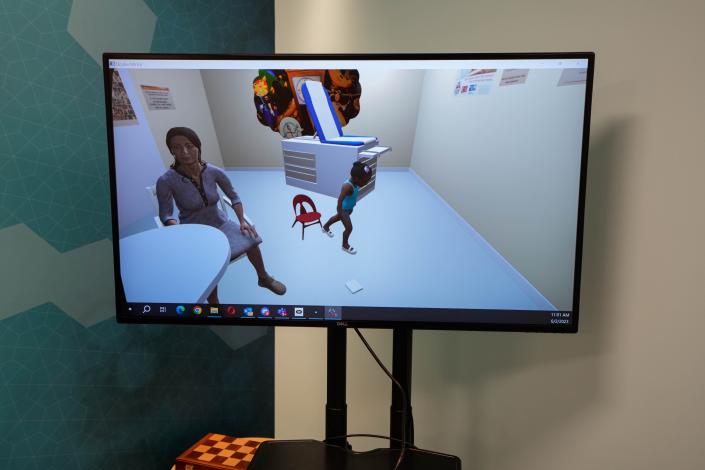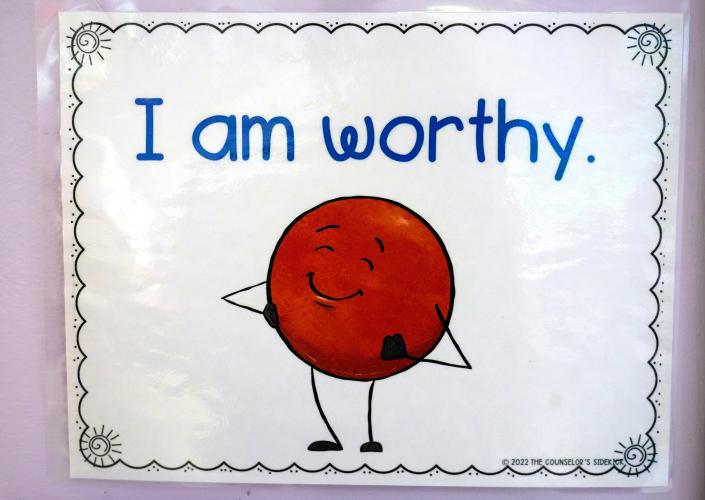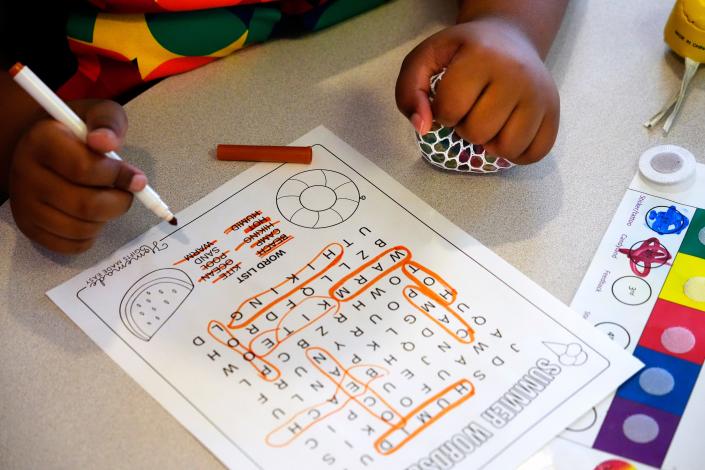
How hard is it for Cincinnati kids to get mental health help? 2,000 are waiting on 1 list
A fourth-grader works with a therapist at Best Point Education and Behavioral Health in Madisonville on June 13. The nonprofit has a long waiting list of kids in the region who need mental health care.
More than 2,000 children are on a waiting list for mental health help at one center alone in the Cincinnati area.
The median time they’ll wait to be seen by a professional: 98 days.
“That is more than 2,000 parents who lie half awake at night … listening and worrying for their children,” said Kate Schroder, president and CEO for Interact for Health, a health equity funder and nonprofit serving 20 counties in Greater Cincinnati.
A mental health crisis among kids is pushing the limits of care throughout the region and across the United States.
In Madisonville, nonprofit Best Point Education and Behavioral Health is a large care provider and serves at-risk children. About 10,000 kids with mental health needs alone get help there annually, said John Banchy, president and CEO. And with the severity of the mental health crisis among kids, the number could grow.
“There is nothing short of calling this a crisis,” Banchy said. As of June 7, Best Point had 2,079 kids on its waiting list.
Children ages 8 to 10 have a motor break between group sessions with Susan King, therapist at Best Point Education and Behavioral Health on June 13. The nonprofit has a 2,000-plus waiting list of kids just for its mental health services, its CEO says.
It isn’t clear how many other kids are waiting for specialized help in the region, but there is no question among health experts that mental health care for kids is nowhere near enough.
In January, Cincinnati Children’s Hospital Medical Center posted on its site that its emergency department was seeing periodic high volumes of mental health-related emergency visits.
The need is still high in Cincinnati and the region, said Dr. Suzanne Sampang, clinical medical director of Cincinnati Children’s Child and Adolescent Psychiatry.
“We continue to try to meet this growing need,” she said, “but demand exceeds the resources available in the community.”
How did we end up with too little care?
The crisis started before kids in the United States – including the Cincinnati region – tumbled into a torrent of mental health struggles – including anxiety disorders, depression, eating and other self-harm disorders and suicidal ideation – during the COVID-19 pandemic. It ballooned from there.
Story continues
“We are faced with headwinds from multiple directions,” Banchy said.
Among them:
-
A long-term shortage of people seeking education to become therapists, psychologists, psychiatrists and mental health care specialists of another kind.
-
Specialists leaving the field because Medicaid reimbursement rates are so low, “and that dictates what we can pay folks,” Banchy said.
-
The severity of mental health conditions in kids worsening, a crisis that continues to need to be addressed with professional help.
Children’s psychiatrist pool too low for child, teen needs, data show
Psychiatrists aren’t the only specialists who can help kids with mental health problems, but their numbers in Ohio, Kentucky and Indiana counties illustrate the shortage in professional care available.
The American Academy of Child and Adolescent Psychiatry estimates that the country needs 47 child and adolescent psychiatrists per 100,000 kids.
But Ohio has about 13 per 100,000. Kentucky has 14 and Indiana has 7, American Academy Child and Adolescent Psychiatry workforce data show. In regional counties, the closest to that 47-psychiatrist mark is Hamilton County, with 26.
Data for the Cincinnati region’s counties show a lack of doctors, as well.
Pediatricians will have to step up training to fill gap
The shortage of specialized care providers signals a need for family care pediatricians to step in. Problem is, there’s insufficient training of primary care pediatricians in how to recognize and address mental health care in children, experts say.
That’s going to have to change: The Accreditation for Graduate Medical Education will require that all pediatric residents get four weeks of mental health training by 2025.
Cincinnati Children’s specialists are already working locally and nationally to make that happen, said Dr. Sue Poynter, director of the hospital’s Pediatric Residency Training Program.
Poynter said the change is essential to the health and well-being of children and teens.
“In order to address the gap in mental health providers and the escalating numbers of mental health diagnoses in pediatric patients, we must graduate pediatricians who are comfortable with the screening, diagnosis, and treatment of common mental and behavioral health issues,” Poynter said.
The Cincinnati Children’s program leaders have designed a plan for a standardized online curriculum addressing mental health topics in pediatric programs across the country, Poynter said.
The American Association of Pediatrics and other industry experts have encouraged general pediatricians to provide more mental health prevention strategies for families, to routinely screen children and adolescents for mental health conditions, to make personal referrals to specialists – and if kids are waiting or are in between appointments, to help kids manage their conditions as part of routine pediatric care.
Virtual training gives pediatric residents mental, behavioral health skills
Cincinnati Children’s Hospital Medical Center has started training pediatric residents in mental health visits with kids and parents through a virtual learning program.
One part of Cincinnati Children’s plan that is underway now involves immersing pediatric residents into settings in which a virtual parent and child act out life-like scenarios that could happen in an office visit.
Dr. Joe Real, a Cincinnati Children’s pediatrician, and Rachel Herbst, a pediatric psychologist, co-developed the curriculum, called Promoting Resilience and Emotional Health through Virtual Education in Training – or Prevent.
The virtual parent in the video asks questions about new and concerning behaviors of her 3-year-old child, who’s “there,” in the video, sitting in the room.
The resident must answer each question using evidence-based responses and remain engaging with the mom and aware of the child, Herbst said. Also during the virtual session, video toddler throws a tantrum. The resident must coach the parent in how to handle the child’s outburst and other behavioral problems.
Herbst said the virtual nature of the training gives the residents a way to practice again and again, until they know how to respond, and are comfortable doing so, in multiple scenarios.
Primary care pediatricians stretch their resources to help now
Some pediatricians’ groups in the Cincinnati area have a mental health professional on the staff to try to address kids’ needs. A lot of family practice doctors screen kids 12 and older for mental health conditions and will make referrals to experts.
One example: St. Elizabeth Physicians pediatricians screen every adolescent for depression, every school sports player and, at medication checks, every patient with ADHD. And they’ll screen for anxiety and other mental health conditions as needed, said Dr. John La Count, pediatrician.
La Count’s office has a social worker who is “integral in providing assistance and counseling to the families.”
”But the wave of kids suffering since the COVID-19 pandemic has been hard to manage with the shortage in support services,” La Count said.
He said pediatricians already have a heavy learning load and adding to it is not a simple process, and there’s still a lack of resources for further care.
One of the signs of support for kids in care at Best Point Education and Behavioral Health in Madisonville.
What else is being done to help?
Cincinnati-area health funders and advocacy groups are working on the kids’ mental health crisis, funding new strategies and services.
Among plans that are underway:
-
Interact for Health is providing more than $2 million in grant funding for youth mental health efforts regionally, including prevention and treatment services in schools, community organizations and clinical providers.
-
bi3, Bethesda’s health-focused funder, has invested $3 million to integrate mental health services in TriHealth’s pediatric practices. The goal is to help kids early on, so hospitalization and other longer term care is not needed.
-
bi3 also is joining community funders, nonprofits and other organizations to support a youth mental health strategy in the region.
-
In 2022, Miami University received $5 million from the state to create a School-Based Center of Excellence for Prevention and Early Intervention to get schools tools they need to support kids’ mental health.
A fourth-grader holds a fidget ball as he completes an exercise with a therapist at Best Point Education and Behavioral Health, in Madisonville.
Those funding the efforts say they know there is no quick route to ending the wait times for mental health help for kids but are hoping to make an impact as soon as possible.
“The crisis calls us to act with unprecedented urgency, and at the same time, we know that results will take time,” Schroder said. “The challenges have been building over years – and it will likely take years to turn the tide.”
“Many families, teachers, and therapists know this urgency firsthand. They live it every day – and are calling us to share in that urgency and to work together to help turn the tide.”
This article originally appeared on Cincinnati Enquirer: Cincinnati area kids in crisis wait on lists for mental health care










